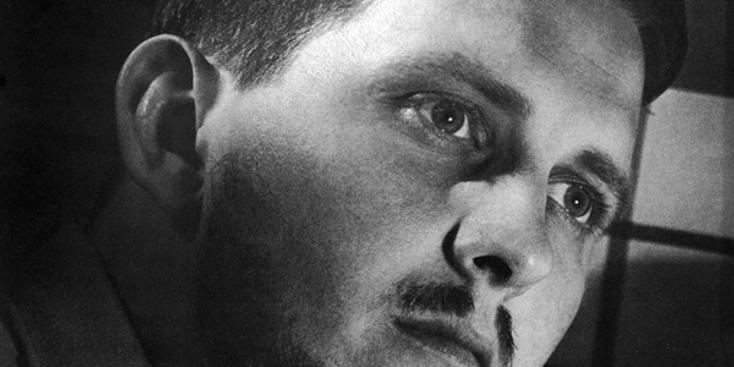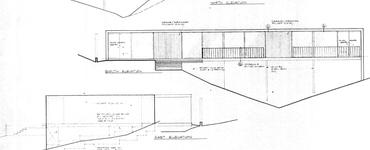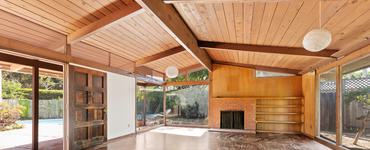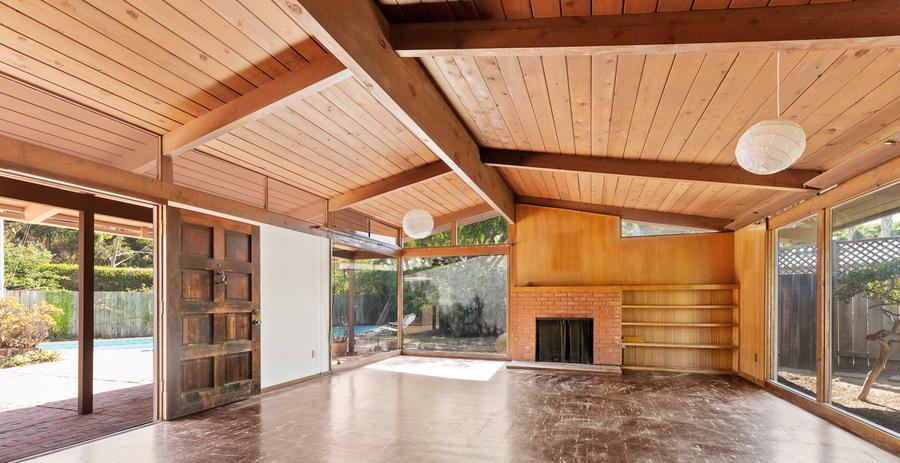Russell Isley Forester
Architect | 1920 - 2002
Russell began his architectural career as a draftsman alongside Lloyd Ruocco before leaving to study at the Institute of Design in Chicago. By the time he obtained his architecture license (1960), Russell had already completed a wealth of modernist structures. Russell Forester spent three decades juggling his passion for fine art and architecture only to give up the latter for the former in 1976.

Born in 1920 in Salmon, Idaho, at age five Russell Forester moved to La Jolla with his younger brother and mother – who notably served as librarian at the Scripps Institution of Oceanography where a number of the architect’s clients would later conduct their research. Russell’s father, an architect, had abandoned the family.
Russell graduated from La Jolla High School in 1938 and later served in the Army Corps of Engineers (1943-46), where he began his architectural career as a draftsman alongside Lloyd Ruocco. Together, with other budding designers, the team designed ‘replacement depots’ while much of his free time away from the drafting table was devoted to drawing.
Russell’s first wife, Eleanor, was born on December 11, 1924, to Eva Lucille Puckett and George Albert Hedenberg. Eleanor moved to San Diego with her mother and stepfather, Kenneth J. Darrell, in 1939. After graduating from Hoover High School she worked in a drafting position for Concrete Shipyards designing barges for the War effort. At Concrete Shipyards, she met Russell and they immediately hit it off, forcing the head draftsman, Lloyd Ruocco, to move their desks apart since Russell spent too much time turning around to talk to her. Eleanor and Russell married on April 13, 1946, in La Jolla.
Mr. Forester opened his first office, at 7438 Cuvier Avenue, in 1948, as a freelance architectural designer. At this early stage of his career, he designed four houses: for Lloyd and Betty Russell at 348 Vista de la Playa, his own home at 724 Rushville, a house for Ruth Dailey on Ludington Place and the Cromwell's home on Vista de la Playa.
Inspired by- and at the urging of Ruocco, not to mention financing from the GI Bill, Russell sought out formal architectural studies. Between 1950-1951 Russell attended the Institute of Design (later IIT) in Chicago where Mies Van Der Rohe and others were spreading the International Style gospel. Founded as the ‘New Bauhaus’ in 1937 by Bauhaus educator László Moholy-Nagy, by the time Russell arrived Serge Chermayeff was serving as its director. Russell later recollected that his foundation course focused on perception, space, light, proportion and texture. Eleanor and Russell returned to San Diego when his mother became ill.
Russell’s formal studies, in Chicago, had a major impact on the development of his approach. While his early works, of 1948-49, were fairly traditional, Russell's work following his time in Chicago were boldly 'contemporary'. His home designs in Scripps Estates Associates, near La Jolla Shores and elsewhere in La Jolla exemplify his new approaches in wood and glass.
Eleanor and Russell built three family homes together before they divorced after 20 years of marriage: their first house at 724 Rushville Street in April 1948; their 2nd house on Hillside Drive in 1952; and a spec house in the upper Shores area in the early 1960s.
Eleanor was an accomplished and successful interior designer. Her company, Eleanor Forester Interiors, based in downtown La Jolla, focused on both commercial and residential projects. She designed dormitory rooms for UC San Diego, a string of banks, homes for Robert Peterson, Harle Montgomery, Joan Holter, William Karatz, and the Sampson, Mayne, Muzzy, Fayman, Kimmell, and the Marston families, among others. Eleanor also did residential work in San Francisco, Hawaii, Mexico, New York, and Montana. Asked to write a monthly column for San Diego Magazine by editor Ed Self, she wrote the "La Jollans are Talking About" column in the early 1960s.
Russell opened his first office at the time his Rushville Street home was “chosen by a distinguished jury as one of the top residences in the United States for Progressive Architecture magazine.” His second home at 7595 Hillside Drive was “displayed in an international architecture exhibit at the Museum of Modern Art in Sao Paulo, Brazil in 1952.” Eleanor and Russell spent a year in Spain in 1955-56 while he “worked for a firm of engineers and architects on U.S. bases in Spain” as designer and supervising architect. After two years, Russell returned stateside “as a designer on the Los Angeles airport for the firm Pereira and Luckman.” By the time he obtained his architectural license, in 1960, Russell had already completed a wealth of modernist structures.
Russell was among the first wave of San Diego architects to emphasize the benefits of ‘steel and glass modernism’, championed elsewhere by the likes of Mies Van Der Rohe, to commercial and residential clients here. From his La Jolla practice, Mr. Forester enjoyed a number of commissions by local art patrons Lynn and Danah Fayman as well as restaurateurs like Bob Peterson. For Foodmaker’s CEO, Peterson, Russell pushed Mieisian modernism into pop culture by designing the first Jack in the Box restaurant in 1951. As Jack in the Box’s “machines for dispensing food” grew to well over 200 drive-thru restaurants inside 20 years, Peterson would also have Russell design the Family Tree, a more elegant setting for dining in San Diego, as well as his personal residence.
Russell Forester defined architecture as problem solving. From his Philosophy of Practice, he wrote, “We believe that good architecture grows out of a thoughtful, direct and imaginative approach to each owner’s individual problem. Our unique systems approach to the total project from the feasibility studies through design and finished construction gives us an economic and functional solution. Our understanding of the complexity of each client’s problems and the professional and artful solution to his needs is our concern. In our practice all functions (architecture, feasibility studies, planning, interiors, color or graphics) are based on a systems approach to the total concept. We know the broad scope of thinking and the individual talent that is brought to bear on each commission. It is unsurpassed. We are entering a new age of building. An age in which a new set of ideas is taking hold. These ideas are not solely technological in nature: they are also philosophical. Relating first to larger questions of environmental planning and then concern for the isolated technical details.”
In parallel to his architecture practice. Russell was an artist. In 1962, San Diego & Point described Russell’s artwork as arresting, constructivist, severe, functionalist, and mainstream all in the same article. Of the second home Forester designed for the Russells, the magazine stated “the house….has a quiet elegance and air of privacy. The feeling, both inside and out, is one of discipline without rigidity, elegance without opulence.”
Russell Forester spent three decades juggling his passion and vision for fine art and architecture only to give up the latter for the former in 1976. With the aid of his second wife and architectural firm partner, Christine, Russell began his full-time career as a painter and sculptor when many of his contemporaries were retiring or at least retiring their modernist principles for safer ground. “Had it been up to him, he would have gone directly into art (rather than architecture). He liked the Bauhaus ideology of diverse disciplines,” remarked widow Christine Forester. “Had he been an artist since his 20s he may have not been as productive. Russell was often discouraged from pursuing his art. By the time he devoted himself full-time to art in his 50s, there was a sense of urgency. By this time his hand was very secure and there was little waste and few mistakes,” said Mrs. Forester.
Russell Forester’s career melding art and architecture was honored by his unusual FAIA recognition. Rather than his career of progressive building designs being honored, Mr. Forester was recognized by his AIA colleagues for his contribution to art and architecture aesthetics. Russell believed the central tenet to integrity of design was his residential client’s lifestyle. Some of his clients would later become patrons of his artwork -- filling their Forester-designed homes with Forester-designed artwork. Clients like Lloyd Russell, Danah Fayman and Bob Peterson commissioned Russell time and again.
One only has to look at the ceiling of Park Prospect Apartments to understand Russell’s fascination with repetition. Many of Mr. Forester’s commissions include rows of small round light bulbs -- these “dots, lines and light” are recurring themes in both his art and architecture. Whether using rows of light diodes, or punctuating his painting and sculpture (sometimes in steel) with a sewing machine, the linear repetition reflected this dots-in-line theme. Additionally, from his La Jolla home, Russell grew fascinated by coastal mist seen through the expansive glass walls. His art often reflects coastal mornings by painting, washing, and repainting and the use of gauze to reflect this misty feeling.
Russell’s building designs varied in material and style over the years he practiced (1948-1976) while retaining central design principles: the problems the client needed solving; and how the whole project was vastly more than the sum of its parts. Clients of Russell Forester Associates Inc. grew to expect a variety of things, central to which was his unquestionable integrity of his designs, passion and vision. During much of Mr. Forester’s career in architecture, San Diego’s mid-century design aesthetic was comprised of a “lack of homogeneity in materials and approach to reflecting the region. People continued to come to San Diego from elsewhere and clients wanted styles that reminded them of where they were from,” Mrs. Forester summarized. She continued, “He was a brilliant man, extremely talented, cut to the chase, detail oriented, never lost track of detail within context of project, and the ‘whole was definitely the sum of the details.”
Partial List of San Diego Projects
Bailey, G. Newton ("Newt") and Doris P. Residence (1954)
2635 Ellentown Road, La Jolla
Bronowski, Jacob and Rita Residence (ca. 1965)
9438 La Jolla Farms Road, La Jolla
*Historically designated
Brown, Dr. James D. Residence (1967)
633 Ranchito Drive, Escondido
Byerly Residence (1969)
1949 Paseo Dorado, La Jolla
*Historically designated
Callahan, Richard and Lucille Residence Addition (1969)
2116 Merida Court, La Jolla
The Cliffs (1973)
7933 Prospect Place, La Jolla
Cromwell, Townsend Residence (1949)
304 Playa del Norte, La Jolla
Cromwell, Townsend and Katherine Residence (1955)
2621 Inyaha Lane, La Jolla
Dailey, Helen Ruth Residence (1948)
7750 Ludington Place, La Jolla
*Historically designated
Devonshire La Jolla (1971)
7811 Eads, La Jolla
Dill, Robert and Gloria Residence (1955)
2605 Ellentown Road, La Jolla
Driver, Robert Residence (1955)
2938 Coast Blvd (2938 Sandy Lane), Del Mar
Edison, Simon and Helen, Residence (1974)
2430 Calle del Oro, La Jolla
*Published - San Diego Union-Tribune 1/22/1995
Family Tree Restaurant (1965)
2929 Shelter Island Drive, San Diego
*AIA Award of Honor – 1966
Fayman, Lynn & Danah Residence #1 (1962)
2545 Ardath Road, La Jolla
Fayman, Danah Residence #2 (1969)
7778 Starlight Drive, La Jolla
Fayman Industrial Building (1966)
3421 Tripp Court, Sorrento Valley
Forester, Russell & Eleanor Residence #1 (1948)
724 Rushville Street, La Jolla
Forester, Russell & Eleanor Residence #2 (1952)
7595 Hillside Drive, La Jolla
Forester, Russell Spec House (1962)
8695 Glenwick Lane, La Jolla
Forester, Russell & Christine Residence (1971)
2025 Soledad Avenue, La Jolla
Forester Office Building (1973)
1241 Cave Street, La Jolla
*Published in the La Jolla Light, 8/2/1973
Frautschy, Jeff and Frances Residence (1954)
2625 Ellentown, La Jolla
Freeman, Dr. Burton Edgar & Elizabeth Louise Residence (1961)
7602 Via Capri, La Jolla
Dr. Freeman was a theoretical nuclear physicist who worked for Oppenheimer and Teller in the 1950s and was recruited to come to La Jolla to establish the new General Atomics Division of General Dynamics.
Freitas Residence (1968)
3022 Donee Diego Drive, Escondido
Gewalt Residence (ca. 1952-56)
360 Dunemere Drive, La Jolla
*Attribution by chain of title and published building permit on 6/19/52 in the San Diego Union page 27; photographed by Maynard Parker
Gist, Richard and Allison Residence (1955)
2512 Horizon Way, La Jolla
Gross, Max Hudson and Louise J. Residence (1963)
5911 Folsom Drive, La Jolla
*Historically designated
Hench, Philip & Barbara Residence (1959)
7856 La Jolla Vista Drive, La Jolla
Herman, Edmund & Elsie Residence (1961)
1262 Fleetridge, La Jolla
*Historically designated
Inman, Douglas and Ruth Residence (1955)
2604 Ellentown Road, La Jolla
Jack in the Box Mark I design (1951)
6270 El Cajon Boulevard, La Mesa
Jack in the Box, Mark II design (mid 1950s)
Various locations
*Published - Los Angeles Times 4/11/1991
Jack in the Box, Mark III design (early 1960s)
Various locations
Jack in the Box
5141 Jackson Drive, La Mesa
Jack in the Box Offices
3233 Kurtz, Midway Area
Jack in the Box
Broadway & H, Chula Vista
Jack in the Box
El Cajon Blvd. & 63rd, La Mesa
Jack in the Box
Imperial & 13th, East Village
Jack in the Box
Massachusetts & University, La Mesa
Jack in the Box
Voltaire & Sunset Cliffs, Ocean Beach
Jack in the Box
30th & Imperial, Grant Hill
Jack in the Box
8025 Broadway, Lemon Grove
Jack in the Box
3850 Clairemont Mesa Blvd, Clairemont Mesa
Jack in the Box
2886 El Cajon Boulevard, North Park
Jack in the Box
1745 Highland, National City
Jack in the Box
5080 Logan, Lincoln Park
Jack in the Box
353 W. Main, El Cajon
Jack in the Box
2295 Market Street, Sherman Heights
Jack in the Box
4104 Mission Boulevard, Mission Beach
Jack in the Box
6070 Mission Gorge Road, Grantville
Jack in the Box
2605 Morena, Bay Park
Jack in the Box
850 Palm, Imperial Beach
Jack in the Box
644 E. San Ysidro Blvd, San Ysidro
*Not at this location
Jack in the Box
3250 University, North Park
*Not at this location
Jack in the Box
786 3rd, Chula Vista
Jefferson Gallery (1965)
7917 Ivanhoe, La Jolla
*San Diego AIA Award of Honor (1966)
Johnston, Mr. & Mrs. Harry E. Residence (1955)
1920 Spindrift Drive, La Jolla
*Attribution via San Diego Union
Jones, Chalmer E. Residence (1962)
9322 La Jolla Farms Road, La Jolla
Klapper, Roy B. Residence (1957)
6433 La Jolla Scenic Drive, La Jolla
La Jolla Country Day School Fountain (1967)
La Jolla
*Award of Merit in 1968 from San Diego AIA
La Jolla Veterinary Hospital (1950)
7520 Fay Avenue,, La Jolla
Mayne, Don & Marilyn Residence (1962)
1774 La Jolla Rancho Road, La Jolla
Mayo Residence (1951)
4940 Resmar Road, La Mesa
Mckellar, Laura Lee and Walter M. Residence (1954)
7890 Torrey Lane, La Jolla
*Historically designated as the Harold and Frieda Daum Urey Residence - the Ureys were the second owners.
Means, Rodney Residence (1962)
8862 La Jolla Scenic Drive, La Jolla
Medical Offices (1965)
121-141 North Fig Street, Escondido
Miller, Paul G. Residence (1959)
6558 Manana Place, La Jolla
Moore, David and Claire Residence (1955)
9440 La Jolla Shores Drive, La Jolla
Mullenix, Dr. & Mrs. Ralph B. Residence (1960)
9440 La Jolla Shores Drive, La Jolla
*Built by Charles E. Chandler; attribution via San Diego Union on November 27, 1966 p.F1).
Nelson, Ralph B. and Sigmund Wald Residence (1961)
8862 La Jolla Scenic Drive, La Jolla
Newmark, Residence for Dr. & Mrs. (1963)
2643 St. Tropez Place, La Jolla
*After arriving in La Jolla in 1963, Ruth and Leonard Newmark interviewed several architects including Lloyd Ruocco, Sim Bruce Richards, Henry Hester and John Lloyd Wright. A founding Linguistics Professor at UC San Diego, Leonard Newmakr hosted a number of events for the campus at the family home. Ruth invested herself as a booster for UCSD’s International Center and launched Gallery 8. Landscape design by Kenneth Hayashi
Olsen Residence (1950)
348 Vista de la Playa, La Jolla
Park Prospect (1963)
800 Prospect, La Jolla
*Historically designated
Patten, Stanley, Rear Admiral Residence (1961)
5850 Beaumont Avenue, La Jolla
Peterson, Robert O. Residence (1964)
567 Gage Lane, Point Loma
*San Diego Home and Garden published in May 2006
*Historically designated
Poppendiek, Heinz and Elizabeth Residence (1965)
7834 Esterel Drive, La Jolla
Private Residence
2643 St. Tropez Place, La Jolla
Private Residence (ca. 1961)
2469 Avenida de la Playa, La Jolla
*Attribution by real estate professional
Private Residence (1961)
8408 Paseo Del Ocaso, La Jolla
Private Residence (1964)
2308 Geranium Street, La Jolla
Private Residence Additions (1962)
7390 Via Capri, La Jolla
*Article states 'designed by architect Roger Matheson'. House features Russell Forester additions circa 1968-1970
Professional Building for Dr. M. Zemlick, and Dr. M. Fader
Upas and First Street, San Diego
*Lot A, Block 391 Horton's Addition, San Diego
Russell, Lloyd and Betty Residence #1 (1948)
348 Vista del Playa, La Jolla
Russell, Lloyd and Betty Residence #2 (1962)
7651 Hillside Drive, La Jolla
Russell, L.E. Residence (1962)
7661 Hillside Drive, La Jolla
Sampson, Horace and Dorothy Residence (1972)
2323 Calle Del Oro, La Jolla
Sanderson, Brig. Genl. Charles R. House (1949)
Location not known
*Published in Los Angeles Times Home Magazine on August 14, 1949
Scharff, Morris & Janice Residence (1961)
2727 Bordeaux Avenue, La Jolla
Schmidt, Dr. A. G. Residence (1961)
1191 Avenida Amantea, La Jolla
Schreiber, A Residence (1956)
5917 Citadel Circle, La Jolla
Shor, George and Betty Residence (1954)
2655 Ellentown, La Jolla
Shumway, George and Ann (Revelle) Residence (1955)
2504 Ellentown Road, La Jolla
Signori, Al and Frances Residence (1968)
7872 Esterel, La Jolla
Smith, Com. & Mrs. W.A. Residence Remodel (1949)
Lots 20 & 21, Block 85, Point Loma
Southern California First National Trust (1974)
4771 Spring Street, La Mesa
*Demolished
Southern California First National Trust (1975)
9846 Campo Road, Casa De Oro
Spiess, Fred and Sarah Residence (1955)
9450 La Jolla Shores Drive , La Jolla
Sunset Engraving (1963)
India and Date Street, San Diego
Tompkins Residence (1962)
7743 Eads Avenue, La Jolla
Whisenand, Dr. James M. and Mrs. Juanita Residence (1958)
6325 Camino del Teatro, La Jolla
Wood, Elizabeth Residence (1953)
2320 Calle Corta, La Jolla
Zane, John Residence (1959)
7813 La Jolla Scenic Drive, La Jolla
Zemlick, Residence for Dr. & Mrs. M.J. Residence (1966-67)
4685 Alta Rica Drive, La Mesa
*1968 landscape plans by Joseph Yamada of Wimmer Yamada Landscape Architecture for Dr. and Mrs. M.J. Zemlick
Inline


SOLD: Freitas House (Unbuilt) by Russell Forester (1976)
SOLD: Freitas House (Unbuilt) by Russell Forester

A spectacular residential lot with views to the south of the San Pasqual Trail and hills below. Just northeast of the Orfila Vineyards and Winery, the neighborhood is close to schools, shopping, San Diego Safari Park and an abundance of outdoor activities. Don't miss the opportunity to build your next home on this unique parcel. Contemporary renderings are under development that riff off an amazing unbuilt design for the site by modernist architect Russell Forester, for the Freitas family, in 1976.
Architect
Russell Isley Forester

SOLD: Spiess House by Russell Forester (1954)
SOLD: Spiess House by Russell Forester

Architect
Russell Isley Forester
SOLD: Park Prospect Condo by Russell Forester (1964)
SOLD: Park Prospect Condo by Russell Forester
Architect
Russell Isley Forester
Can't Miss Modern!
Sign up for our newsletter and get exclusive content from Modern San Diego.